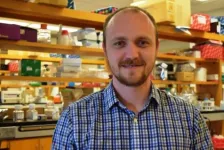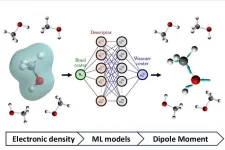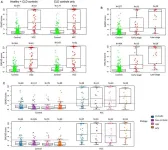(Press-News.org) Atlanta, GA — Oct. 23, 2024 — Researchers at Winship Cancer Institute of Emory University have identified a novel type of immune cell, called the stem-like CD4 T cell, that plays a pivotal role in anti-tumor immunity. The pre-clinical findings, published in Nature, highlight the potential to activate these cells to fight tumors more effectively, offering new hope for broader treatment success, particularly in patients with cancer that is unresponsive to current immunotherapies.
Led by Haydn T. Kissick, PhD, researcher in the Cancer Immunology Research Program at Winship Cancer Institute and assistant professor in the Department of Urology at Emory University School of Medicine, the study reveals that these stem-like CD4 T cells reside in the lymph nodes near tumors. While capable of driving a powerful anti-tumor response, these cells often remain inactive, limiting the immune system’s response to the tumor.
The stem-like CD4 T cells have the ability to renew themselves and transform into different immune cell types. These cells are marked by two specific proteins, PD1 and TCF1, which help determine their behavior, including self-renewal and regulation. In lab models, activating these cells made a common immunotherapy treatment called PD1 blockade more effective against cancer.
“In around 10% of patients where the stem-like CD4 cell is active, there is a far more vigorous immune response to the cancer,” says Kissick. “These patients survive longer after surgery and are much more likely to respond to checkpoint immunotherapy. However, the challenge we identified is that in most patients, this cell remains in a suppressive state, which essentially tells the immune system to remain idle and ignore the tumor.”
First author Maria Cardenas emphasizes the significance of overcoming this suppression: “Most importantly, while finding the immune system of patients with cancer in this idle state is common, we discovered that the stem-like CD4 T cell is capable of switching to an active state. It can restart a powerful anti-tumor immune response and enhance responsiveness to PD1 blockade in animal models.”
The findings suggest that almost all patients have this stem-like CD4 T cell in the lymph nodes surrounding their tumors. “Understanding how to teach these cells to switch between the active and idle states could identify new ways to treat many more patients with immunotherapy,” Kissick explains.
Future exploration of this discovery is needed to determine how to turn the cells’ immune response on and keep it on. Researchers aim to use mRNA and lipid nanoparticle (LNP) technology to re-program these stem-like CD4 T cells, effectively removing the brakes on the immune response to cancer.
“We still have many questions to answer and challenges to overcome,” says Kissick. “I feel confident that Winship of Emory is the place for these discoveries and advancements to be made and to determine how to leverage these mechanisms to target the cells and direct them to do what we need them to do to turn on the immune response. We have all the pieces of the puzzle here, it’s just a matter of putting them together. Our Phase I Clinical Trials Unit is robust, and we have the contributions of physicians and patients here too.”
A team of researchers from Winship Cancer Institute co-led and contributed to this research, including Martin Sanda, MD, researcher in Winship’s Cancer Prevention and Control Research Program and professor and chair of the Department of Urology at Emory University School of Medicine; Mehmet Bilen, MD, and Vikram Narayan, MD, researchers in Winship’s Discovery and Developmental Therapeutics Research Program; and Shreyas Joshi, MD, MPH, and Viraj Master, MD, PhD, researchers in Winship’s Cancer Prevention and Control Research Program.
This study was supported by grants from the National Institutes of Health, The Prostate Cancer Foundation, Cancer Research Institute and James M. Cox Foundation.
END
Immune cell discovery offers new potential for cancer immunotherapy
Winship study paves the way for more patients to benefit from future immunotherapies
2024-10-25
ELSE PRESS RELEASES FROM THIS DATE:
“Well-man” thrown from castle identified from 800-year-old Norse saga
2024-10-25
A passage in the Norse Sverris Saga, the 800-year-old story of King Sverre Sigurdsson, describes a military raid that occurred in AD 1197, during which a body was thrown into a well at Sverresborg Castle, outside Trondheim in central Norway, likely as an attempt to poison the main water source for the local inhabitants. A new study published in the Cell Press journal iScience on October 25 describes how researchers used ancient DNA to corroborate the events of the saga and discover details about the “Well-man,” blending history and archaeology ...
Social media and suicide risk in youth
2024-10-25
About The Study: This overview identifies research gaps and methodological challenges that need to be addressed to guide intervention strategies and future policy relevant to youth and suicide risk.
Corresponding Author: To contact the corresponding author, Lisa H. Jaycox, PhD, email lisa.jaycox@nimh.gov.
To access the embargoed study: Visit our For The Media website at this link https://media.jamanetwork.com/
(doi:10.1001/jamanetworkopen.2024.41499)
Editor’s Note: Please see ...
Hospitalization for COVID-19, other respiratory infections, and postacute patient-reported symptoms
2024-10-25
About The Study: This cohort study found that postacute infection syndrome is not unique to COVID-19; it can also occur in people with other severe lower respiratory tract infections (LRTIs). However, compared with other LRTIs, COVID-19 appeared to impose an extra burden of neurological, cognitive, and fatigue symptoms. These findings highlight the similarities and differences between post–COVID-19 condition and postacute infection syndrome triggered by other pathogens, which will inform tailored clinical management and offer mechanistic insights into these previously overlooked syndromes.
Corresponding Author: To contact the corresponding author, Junqing Xie, ...
Metabolic bariatric surgery in the era of GLP-1 receptor agonists for obesity management
2024-10-25
About The Study: This cross-sectional study of privately insured patients found a more than 2-fold increase in use of glucagon-like peptide-1 receptor agonists (GLP-1 RAs) as anti-obesity medications from 2022 to 2023, with a 25.6% decrease in the rate of metabolic bariatric surgery during the same period. Our results provide a national contemporaneous estimate of the decline in metabolic bariatric surgery associated with the era of GLP-1 RAs.
Corresponding Author: To contact the corresponding author, Thomas C. Tsai, ...
‘The way to a man’s heart disease’: Can social expectations of masculinity be bad for cardiovascular health?
2024-10-25
Cardiovascular disease remains a top cause of sickness and death in the U.S. and worldwide. Doctors and researchers have it especially high on their radar because it’s more modifiable and preventable than many other diseases and causes of death.
Importantly, though, modification and prevention rely on early detection and mitigation of risk factors like hypertension and high cholesterol. Unfortunately, detection and mitigation are suboptimal throughout the U.S. population: Experts estimate that up to 75% of young adults who have risk factors such as hypertension and high cholesterol are unaware ...
New machine learning model quickly and accurately predicts dielectric function
2024-10-25
Researchers Tomohito Amano and Shinji Tsuneyuki of the University of Tokyo with Tamio Yamazaki of CURIE (JSR-UTokyo Collaboration Hub) have developed a new machine learning model to predict the dielectric function of materials, rather than calculating from first-principles. The dielectric function measures the polarization of negative and positive charges within materials, the phenomenon underlying dielectric materials. Thus, the fast and accurate prediction of dielectric function facilitates the development of novel dielectric materials, an ingredient of many cutting-edge technologies such as 6G ...
Malicious social media bots increased significantly during the COVID-19 pandemic and continue to influence public health communication
2024-10-25
The information environment in Finland during the coronavirus pandemic was exceptional and intense in many ways. The spread of disinformation and the number of actors involved reached unprecedented levels. The demand for accurate information was enormous, and the situation was constantly evolving. Information was disseminated through various channels. Official information played a crucial role, but at the same time, social media posed challenges in the fight against false and misleading information.
Malicious bots increased significantly during the pandemic. The operation of bots – i.e. ...
Sociodemographic factors associated with depression among people living with human immunodeficiency virus on antiretroviral therapy at a university teaching hospital in a Nigerian cosmopolitan city
2024-10-25
Background and objectives
Depression can lead to poor outcomes during antiretroviral therapy, and current evidence suggests high rates of depression among people living with human immunodeficiency virus (PLHIV), especially in low-and middle-income countries. This study was designed to investigate the sociodemographic factors associated with depression among PLHIV on antiretroviral therapy in a Nigerian cosmopolitan city.
Methods
A hospital-based, cross-sectional study was conducted among 592 consenting, ...
Surveillance imaging and GAAD/GALAD scores for detection of hepatocellular carcinoma in patients with chronic hepatitis
2024-10-25
Background and Aims
Early detection of hepatocellular carcinoma (HCC) is crucial for improving survival in patients with chronic hepatitis. The GALAD algorithm combines gender (biological sex), age, α-fetoprotein (AFP), Lens culinaris agglutinin-reactive fraction of AFP (AFP-L3), and protein induced by vitamin K absence or antagonist-II (PIVKA-II) for HCC detection. Similarly, the GAAD algorithm incorporates gender (biological sex), age, AFP, and PIVKA-II. This study aimed to assess the clinical utility of AFP-L3 in the GALAD algorithm and its potential synergies with ultrasound. We compared the clinical performance of GALAD with GAAD; AFP; AFP-L3; and PIVKA-II, with ...
Advanced liver fibrosis predicts liver outcomes in biopsy-proven metabolic dysfunction-associated steatotic liver disease
2024-10-25
Background and Aims
Data regarding risk factors and long-term outcomes of U.S. patients with biopsy-proven metabolic dysfunction-associated steatotic liver disease (MASLD) are limited. This study aimed to investigate the role of clinical and histologic risk factors on long-term outcomes in patients with MASLD.
Methods
A retrospective cohort study of 451 adults with biopsy-proven MASLD was conducted at a U.S. academic hospital from 2012 to 2020. An experienced pathologist evaluated the index liver biopsy. Patients with a prior liver transplant or alternative etiologies of chronic liver disease were excluded. The duration ...
LAST 30 PRESS RELEASES:
Injectable breast ‘implant’ offers alternative to traditional surgeries
Neuroscientists devise formulas to measure multilingualism
New prostate cancer trial seeks to reduce toxicity without sacrificing efficacy
Geometry shapes life
A CRISPR screen reveals many previously unrecognized genes required for brain development and a new neurodevelopmental disorder
Hot flush treatment has anti-breast cancer activity, study finds
Securing AI systems against growing cybersecurity threats
Longest observation of an active solar region
Why nail-biting, procrastination and other self-sabotaging behaviors are rooted in survival instincts
Regional variations in mechanical properties of porcine leptomeninges
Artificial empathy in therapy and healthcare: advancements in interpersonal interaction technologies
Why some brains switch gears more efficiently than others
UVA’s Jundong Li wins ICDM’S 2025 Tao Li Award for data mining, machine learning
UVA’s low-power, high-performance computer power player Mircea Stan earns National Academy of Inventors fellowship
Not playing by the rules: USU researcher explores filamentous algae dynamics in rivers
Do our body clocks influence our risk of dementia?
Anthropologists offer new evidence of bipedalism in long-debated fossil discovery
Safer receipt paper from wood
Dosage-sensitive genes suggest no whole-genome duplications in ancestral angiosperm
First ancient human herpesvirus genomes document their deep history with humans
Why Some Bacteria Survive Antibiotics and How to Stop Them - New study reveals that bacteria can survive antibiotic treatment through two fundamentally different “shutdown modes”
UCLA study links scar healing to dangerous placenta condition
CHANGE-seq-BE finds off-target changes in the genome from base editors
The Journal of Nuclear Medicine Ahead-of-Print Tip Sheet: January 2, 2026
Delayed or absent first dose of measles, mumps, and rubella vaccination
Trends in US preterm birth rates by household income and race and ethnicity
Study identifies potential biomarker linked to progression and brain inflammation in multiple sclerosis
Many mothers in Norway do not show up for postnatal check-ups
Researchers want to find out why quick clay is so unstable
Superradiant spins show teamwork at the quantum scale
[Press-News.org] Immune cell discovery offers new potential for cancer immunotherapyWinship study paves the way for more patients to benefit from future immunotherapies




